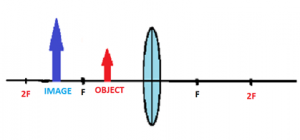This set of Tricky Engineering Physics Questions and Answers focuses on “Lenses – 2”.
1. What is the SI unit for the power of the lens?
a) Watt
b) Dioptre
c) Meter
d) Centimeter
View Answer
Explanation: SI unit for the power of lens is Dioptre. SI unit for focal length is metre. SI unit for quantifying the rate of energy transfer is watt.
2. The lens power is 1D, what will be its focal length in centimeter?
a) 100
b) 0.91
c) 0.1
d) 10
View Answer
Explanation: Since, Lens power is reciprocal of focal length in meter, i.e.,
P=1/f
=> f=1/P
=> f=1/1
therefore, f=1 meter which is, 100 cm
3. Name the lens used in a simple microscope.
a) Biconvex
b) Biconcave
c) Plano-convex
d) Cylindrical
View Answer
Explanation: Biconvex Lens is used in a simple microscope. Whereas, plano-convex Lens is used in a Kellner’s eyepiece, Ransden eyepiece and Gauss eyepiece.
4. If the magnification is positive and greater than unity, what does it indicate?
a) Virtual image
b) Real image
c) Distorted image
d) Erect image
View Answer
Explanation: For virtual image, the magnification is positive and greater than unity.
Since, m = h2/h1 = length of image / length of object = distance of image / distance of object
For real image, the magnification is negative.
5. What will be the power of convex lens having focal length 50 cm?
a) +2 D
b) -2 D
c) +50 D
d) -6 D
View Answer
Explanation: The reciprocal of focal length is power.
.i.e., P=1/f (f in meter)
=> P = 1/50 * 10-2 = 1/50 * 0.001
=> f = 2 D.
Foe convex lens P = positive. Therefore, P = +2 D.
6. What will be the focal length of a convex lens having power -1.5 D?
a) -66.66 cm
b) +66.66 cm
c) +1.5 cm
d) -1.5 cm
View Answer
Explanation: The reciprocal of focal length is power.
.i.e., P=1/f (f in meter)
=> f = 1 / P * 10-2 = – {1/ 1.5* 10-2} = -{ 1/1.5 * 0.001}
=> f = – 1000 / 15
Therefore, f = -66.66 cm.
7. How will be the image formed, when an object is placed 12 cm from a convex lens, whose focal length is 10 cm?
a) Virtual and enlarged
b) Virtual and reduced in size
c) Real and enlarged
d) Real and reduced in size
View Answer
Explanation: here, the object is beyond F and before 2F .i.e., in between F and 2F so, the image formed by convex lens will be real, inverted and magnified (or enlarged).
8. At what distance the object should be placed, when convex lens is used as simple magnifying glass?
a) Less than one focal length
b) Less than twice the focal length
c) More than one focal length
d) More than twice the focal length
View Answer
Explanation: A converging lens bends the light away from the object, making it appear larger when held close to an object. The object must be placed between the lens and the focal point (F) of the lens, to view an upright, enlarged image as shown below:

9. What type of image is produced by a concave lens?
a) Always virtual and enlarged
b) Always real
c) Always virtual and reduced in size
d) Sometimes real and sometimes virtual
View Answer
Explanation: Concave lens produces an image that is always virtual and reduced in size. While convex lens produces virtual image only when the object is in between focus and curvature.
10. At what distance the image will be formed when an object is placed 25 cm from a convex lens whose focal length is 10 cm?
a) 50 cm
b) 5.66 cm
c) 6.66 cm
d) 16.66 cm
View Answer
Explanation: According to Gauss’s formula for lens:
=>1/v – 1/u = 1/f
=>1/v – 1/(-25) = 1/10
=>1/v = 1/10 – 1/25
=>1/v = 6/100
=>v = 100/6
therefore, v = 16.66 cm.
11. What is the least distance for distinct vision?
a) 25 m
b) 25 cm
c) 25 mm
d) 2.5 cm
View Answer
Explanation: The least distance for distinct vision is 25 cm. It is defined as the minimum comfortable distance between the object and the eye lens to form a clear image.
12. A ray of light travels from a medium of refractive index m1 to a medium of refractive index m2. If “i” and “r” are the angle of incidence and refraction, then what is sin(i)/sin(r)?
a) m1
b) m2
c) m12
d) m21
View Answer
Explanation: By Snell’s law:
m1*sin(i) = m2*sin(r)
=> sin(i)/sin(r) = m2/m1 = m21
therefore, sin(i)/sin(r) = m21.
Sanfoundry Global Education & Learning Series – Engineering Physics.
To practice Tricky questions and answers on all areas of Engineering Physics, here is complete set of 1000+ Multiple Choice Questions and Answers.
If you find a mistake in question / option / answer, kindly take a screenshot and email to [email protected]
